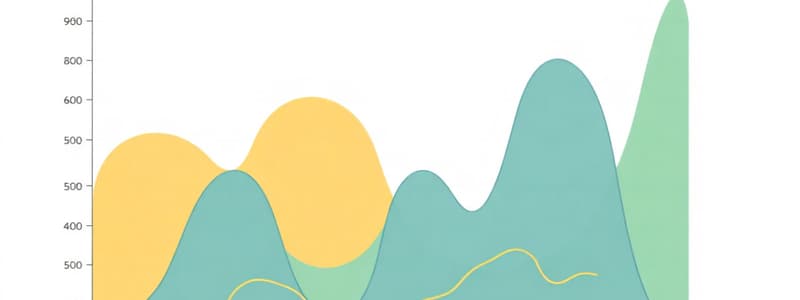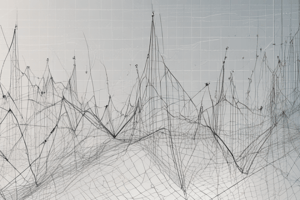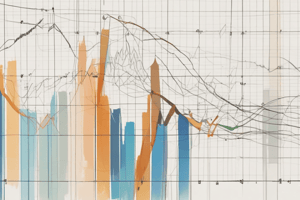Podcast
Questions and Answers
What does the stem component of a value refer to in a stem and leaf plot?
What does the stem component of a value refer to in a stem and leaf plot?
- The rightmost digit of the value
- All digits except for the rightmost digit (correct)
- Only the decimal part of the value
- The entire number including the decimals
How should the leaves be arranged when constructing a stem and leaf plot?
How should the leaves be arranged when constructing a stem and leaf plot?
- In any random order without consideration for size
- In ascending order, from smallest to largest for each stem (correct)
- In descending order from the largest stem to the smallest
- In pairs with their corresponding stems together
In a stem and leaf plot, where should the largest stem be positioned?
In a stem and leaf plot, where should the largest stem be positioned?
- At the bottom of the plot only
- In the middle of the plot for balance
- At the top or bottom depending on preference (correct)
- Only on the right side of the leaves
Which of the following correctly describes the purpose of a stem and leaf plot?
Which of the following correctly describes the purpose of a stem and leaf plot?
What is the primary advantage of using a stem and leaf plot, compared to a histogram?
What is the primary advantage of using a stem and leaf plot, compared to a histogram?
What is the primary purpose of organizing data into a frequency distribution?
What is the primary purpose of organizing data into a frequency distribution?
In a frequency distribution, what types of data are typically represented by categories and counts?
In a frequency distribution, what types of data are typically represented by categories and counts?
What is the first step mentioned in the process of summarizing data?
What is the first step mentioned in the process of summarizing data?
During a survey aimed at assessing job satisfaction in dental hygiene, what type of data was likely collected?
During a survey aimed at assessing job satisfaction in dental hygiene, what type of data was likely collected?
Which statement best describes the role of frequency tables in analyzing sample data?
Which statement best describes the role of frequency tables in analyzing sample data?
What demographic trend does the line graph regarding Japanese women reflect from 1930 to 2000?
What demographic trend does the line graph regarding Japanese women reflect from 1930 to 2000?
Which event caused a notable break in the declining trend of birth rates in Japan?
Which event caused a notable break in the declining trend of birth rates in Japan?
If the current trends continue, what is the expected outcome for the Japanese population?
If the current trends continue, what is the expected outcome for the Japanese population?
Which time period showed the most drastic drop in lifetime births per woman in Japan?
Which time period showed the most drastic drop in lifetime births per woman in Japan?
What is indicated by the statement that the lifetime births per woman in Japan in 2000 is less than one-third of that in 1930?
What is indicated by the statement that the lifetime births per woman in Japan in 2000 is less than one-third of that in 1930?
What type of data can be represented with a line graph according to the content?
What type of data can be represented with a line graph according to the content?
In the context of dental treatments, what was one of the categories mentioned regarding prosthodontic treatments?
In the context of dental treatments, what was one of the categories mentioned regarding prosthodontic treatments?
What is the primary purpose of the survey question regarding appointment length?
What is the primary purpose of the survey question regarding appointment length?
Which of the following best describes what occurred to Japan's birth rate post-1980?
Which of the following best describes what occurred to Japan's birth rate post-1980?
How are the responses to the ordinal data typically categorized in the study?
How are the responses to the ordinal data typically categorized in the study?
In the combined data, how many individuals responded with 'neutral'?
In the combined data, how many individuals responded with 'neutral'?
What does the study suggest as a possible cause for root canal failure?
What does the study suggest as a possible cause for root canal failure?
Which of the following is NOT a response option provided in the survey?
Which of the following is NOT a response option provided in the survey?
Which two response categories could be combined to simplify the frequency distribution?
Which two response categories could be combined to simplify the frequency distribution?
What innovative methods are being introduced in endodontic therapy according to the study?
What innovative methods are being introduced in endodontic therapy according to the study?
How many total responses were collected in the survey questionnaire regarding appointment length?
How many total responses were collected in the survey questionnaire regarding appointment length?
What is the approximate number of intervals needed for a data set with 90 observations?
What is the approximate number of intervals needed for a data set with 90 observations?
How does the range of values in a data set affect the number of required intervals?
How does the range of values in a data set affect the number of required intervals?
What is the formula for determining the width of each interval in a frequency distribution?
What is the formula for determining the width of each interval in a frequency distribution?
What should be the first step when constructing a frequency distribution?
What should be the first step when constructing a frequency distribution?
Which of the following statements is true regarding the selection of non-overlapping intervals?
Which of the following statements is true regarding the selection of non-overlapping intervals?
In general, how many intervals should one aim for when dealing with a large data set?
In general, how many intervals should one aim for when dealing with a large data set?
What is indicated by the symbol ‘≅’ in the context of mathematical approximation?
What is indicated by the symbol ‘≅’ in the context of mathematical approximation?
If a data set comprises a small number of measurements, what should be the approach regarding intervals?
If a data set comprises a small number of measurements, what should be the approach regarding intervals?
Flashcards are hidden until you start studying
Study Notes
Line Graphs
- A line graph with an x-axis representing time allows for comparison of quantity changes over a defined period.
- An example of this is the number of lifetime births per Japanese woman.
- The rate of births has decreased steadily since 1930 except for a break between 1960 and 1970.
- Japan's birth rate is lower than the replacement level of 1.7-1.8.
- The birth rate has been below 1.7-1.8 since 1980 resulting in a shrinking population.
- More than one group's data can be represented in the same line graph which allows for comparisons.
Stem and Leaf Plots
- Separate each value into a stem and a leaf.
- The stem consists of all digits except for the rightmost digit, which is the leaf.
- For example, 76.8 has a stem of 76 and a leaf of 8.
- The smallest stem value is placed at the top of the plot with the largest stem at the bottom.
- The leaves are arranged in ascending order to the right of the stem's vertical line.
Frequency Distribution
- Summarize data by organizing it in a frequency table.
- Shows how many times each data point appears in the data set.
- The first step to summarizing data is to create a frequency distribution, which is a table showing how often each data point occurs in a set.
- Frequency distributions are used for nominal and ordinal data.
- Example 1: Table F1 displays prosthodontic services provided during 1991–1998.
- Example 2A: Table F2 displays results of a survey on job satisfaction which shows responses to a question related to appointment length.
- Example 3: Table F3 illustrates the effect of disinfection by laser irradiation on the bacteria in dentinal tubules.
- Frequency distributions are useful in visualizing the data and identifying trends.
- A frequency distribution for nominal or ordinal data shows the number of observations in each category.
- For ordinal data categories such as strongly disagree to strongly agree, they can be combined.
Frequency Distributions (continued)
- Use 10-20 intervals in a frequency distribution.
- The number of intervals should be approximately equal to the square root of the number of observations (√n).
- The interval width is calculated by dividing the range by the number of intervals.
- Table F4 shows the number of observations and range of values for the bacterial colony data.
- The frequency distribution is constructed by:
- Selecting the number of non-overlapping intervals
- Choosing a starting point for the lowest class limit (which can be the smallest value or a convenient number less than the smallest observed value)
- Determining the upper and lower limits for each interval
- Counting the number of observations in each interval.
Studying That Suits You
Use AI to generate personalized quizzes and flashcards to suit your learning preferences.




